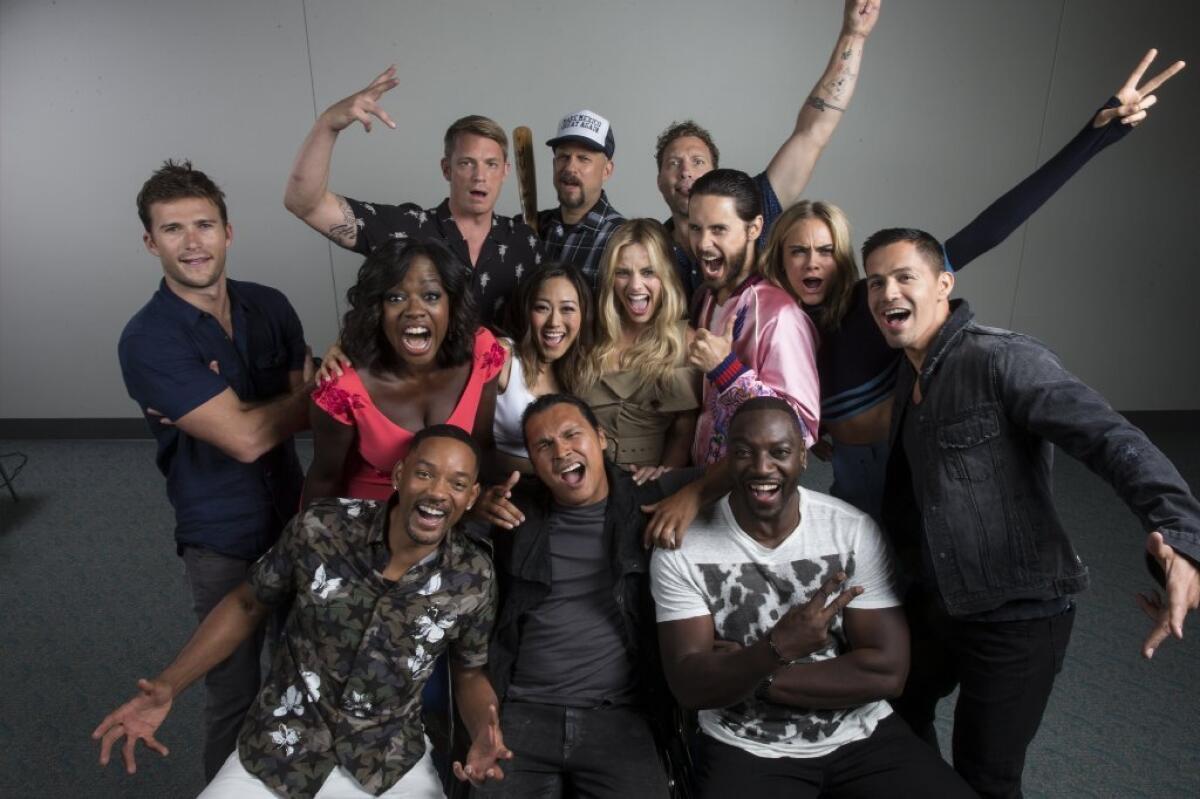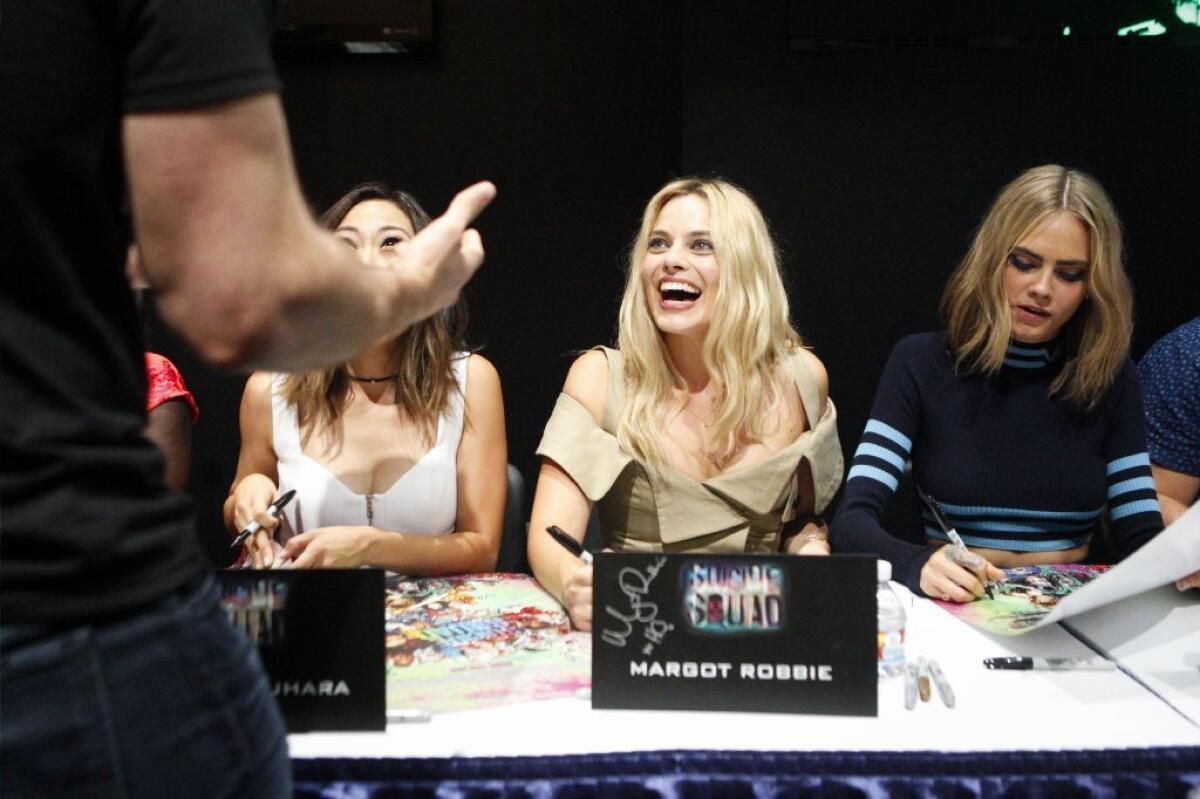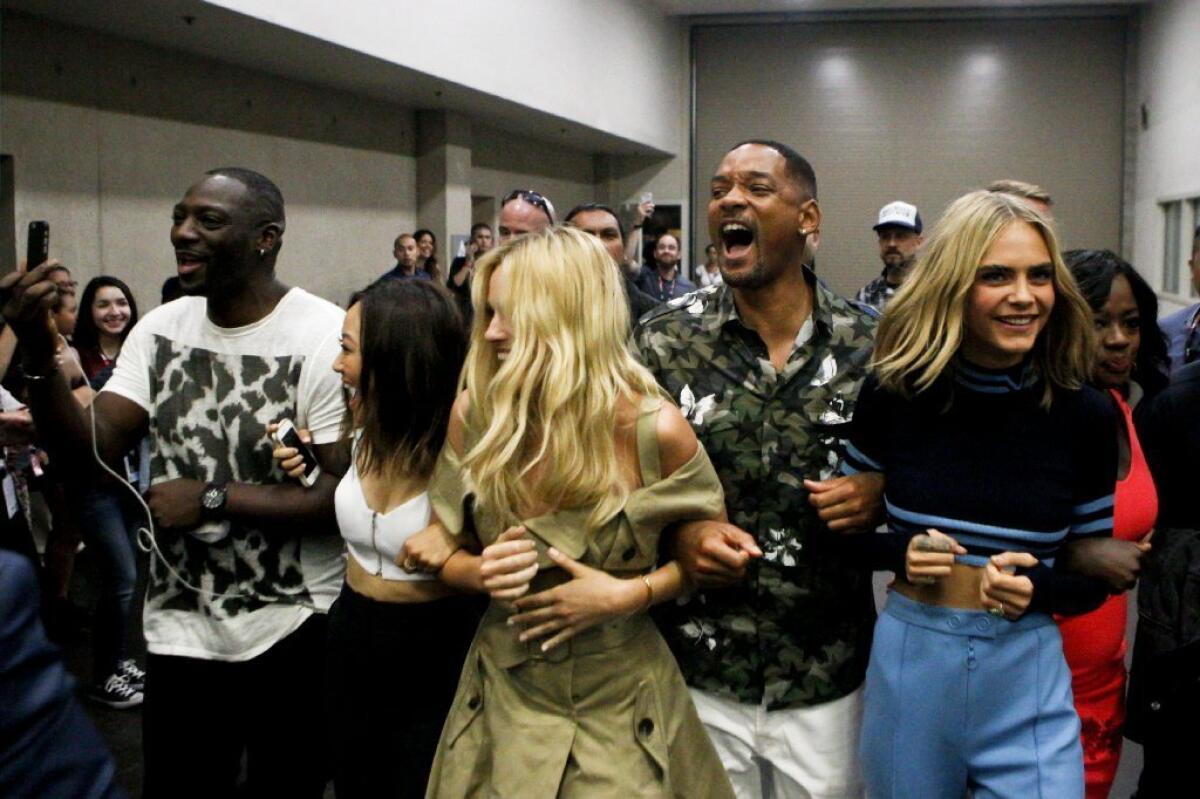Inside the ‘Suicide Squad’ star tour and why Warner Bros. needs the movie to work, and work big

- Share via
Reporting from San Diego — Last Saturday, director David Ayer stood on the convention floor at Comic-Con, wearing a baseball hat that read “Make Mexico Great Again,” shaking his head in disbelief.
All around him at an autograph signing event for his new supervillain mash-up movie, “Suicide Squad,” fans screamed and clamored for photos of the film’s stars, including Will Smith, Margot Robbie, Jared Leto and Viola Davis. With the movie less than two weeks from its Aug. 5 release, Ayer tried to wrap his brain around what he was seeing.
“This is just insane,” he said. He paused, looking simultaneously pleased and somewhat stunned by the frenzy of the crowd. “Expectations are a ...” — a sentiment he capped with a profanity.

Ayer hadn’t banked on quite this level of feverish anticipation when he signed on two years ago to write and direct “Suicide Squad.” The edgy, irreverent project about a ragtag group of villains brought together by the government to fight an even greater evil was something of a misfit among Warner Bros.’ bigger, shinier DC superhero movies. Centered on characters relatively unknown among non-comic-book aficionados, “Suicide Squad” was “sort of the redheaded stepchild of the DC universe,” Ayer said.
PHOTOS: Will Smith leads Suicide Squad cast at Comic Con ‘meet-and-greet’ »
After the critical bashing and lower-than-predicted box office performance of this spring’s “Batman v Superman: Dawn of Justice,” though, everything changed. As Warner Bros. reshuffled the leadership structure overseeing its critically important DC slate – appointing Jon Berg, Warner Bros.’ executive vice president of development and production, and DC Entertainment President and Chief Creative Officer Geoff Johns to lead DC Films – the spotlight turned with new intensity to “Suicide Squad,” raising the stakes for its success to previously unimagined levels.
Now, both in the Warner Bros. executive suites and among legions of die-hard DC fans around the world, all eyes are on the bad guys to save the day.
“It’s a wonderful thing and then, of course, it’s added pressure,” said “Suicide Squad” producer Charles Roven, who produced Christopher Nolan’s blockbuster Dark Knight trilogy as well as “Man of Steel” and “Batman v Superman.” “It’s the yin and yang of being hot.”
Like 20th Century Fox’s smash “Deadpool,” which grossed more than $780 million worldwide earlier this year, “Suicide Squad” is built around cynical, damaged antiheroes rather than square-jawed, caped do-gooders.
Released from prison as part of a secret program, a band of notorious villains — including the ruthless assassin Deadshot (Smith), the reptilian mutant Killer Croc (Adewale Akinnuoye-Agbaje) and the Joker’s (Leto) unhinged psychiatrist-turned-accomplice, Harley Quinn (Robbie) – is forced to join the fight against a greater threat to humanity. Ben Affleck’s Batman makes a few brief appearances, but otherwise “Suicide Squad” belongs entirely to the baddies.
Stories of hardened, rough-and-tumble men have long been a stock-in-trade-for Ayer, whose writing and directing credits include the 2012 crime drama “End of Watch” and the 2014 World War II tank film “Fury.” From the start, “Suicide Squad” meshed nicely with what he calls his “jaded worldview.”
“The world it takes place in is very Cold War in outlook, and I’m a child of the Cold War,” said Ayer, 48. “I liked the idea of the government running covert ops, using bad guys to do good things against other bad guys. It just seemed very close to the world we’re in today.”

Watch the official “Suicide Squad” footage revealed at Comic-Con.
Ayer’s “bad versus evil” pitch drew Smith to the project before a script had even been written, along with the prospect of playing a character who has appeared in comics for years but had never been portrayed on the big screen.
“I get to define the first Deadshot,” said Smith, who played a misanthropic vigilante superhero in 2008’s “Hancock” but is generally better known for portraying unvarnished heroes. “That’s a beautiful thing for me to be able to have that benefit. That’s really rare.”
Leto was faced with the opposite situation, stepping into a character in the Joker who has been portrayed numerous times on film and in television over a half century, including in an Oscar-winning turn by Heath Ledger in “The Dark Knight.”
“There’s been such great work done on this character over the years by so many phenomenal actors and artists and writers,” said Leto, who shaved off his eyebrows and buffed up to play the Joker as a kind of menacing gangster. “I was very aware of the responsibility that goes along with it.”
And, by all accounts, Leto took that responsibility utterly seriously, staying in character on the set and sending his castmates disturbing, Joker-esque gifts.
“He sent me a dead pig and a bunch of maggots,” Smith said. He laughed. “Yeah, he was full-in. He made it very clear he was going in as deep on a summer comic-book movie as he would on ‘The Dallas Buyers Club.’ That sort of shook everybody to step up their game.”

During the film’s shoot in Toronto last year, Ayer and his cast felt relatively free from overarching business pressures. “We were kind of the wild card, the unexpected addition to the DC universe,” said Robbie, whose Harley Quinn has become the film’s breakout character. “It was good for the creative side. No one was playing it safe because there wasn’t a burden of having high expectations.”
Still, with a $175 million net production budget – far higher than the modest $58 million “Deadpool” cost – Ayer did have to make certain concessions to the bottom line. Though his previous films as a director have been squarely in R-rated territory, he reined in the violence to hit a PG-13 rating, even when it meant going against his own inclinations.
“On set, I was like my own cop,” he said. “The special effects guys would be, like, ‘Let’s blow his head off!’ and I was, like, ‘No, chill. We’ve got to hit the rating.’ I couldn’t believe these words were coming out of my mouth.”
In late March, as “Batman v Superman” was hitting theaters, “Suicide Squad” underwent reshoots – a fairly routine part of the production process for a major studio film. Reports soon surfaced on the Internet, however, that Warner Bros. was trying to inject more humor into the film to distinguish it from “Batman v Superman,” which many deemed excessively grim, and satisfy the same appetite for comic mayhem that had propelled “Deadpool” to success.
Producer Richard Suckle, who was closely involved with the “Suicide Squad” reshoots, says those reports were off-base. “It was really never about ‘How do we make the movie funnier?’ ” Suckle said. “The movie is funny throughout, and it was when we shot it.”
“The reshoots-for-humor meme pissed me off so much,” Ayer said. “I mean, I’ve got a crocodile and a lady in hot pants with red and blue hair. It’s, like, Come on, man, it’s not going to be that serious out of the gate!”
Instead of a sign of nervousness from the studio, Ayer says, the reshoots were a vote of confidence in the film. “We knew good things were happening with this movie and it’s, like, ‘OK, dude, what do you want? How can we bolt on some chrome rims and put some 20-inch MTX speakers in the back?’ ”
Roven, who is producing other upcoming DC movies, including Zack Snyder’s “Justice League” and Patty Jenkins’ “Wonder Woman,” says that the darkly comic, subversive tone of “Suicide Squad” shows that all the DC films will have a different feel depending on the director at the helm.
“That was one of the most exciting things about it,” Roven said. “It was the right film at the right time to make the statement that we wanted these films to be of the same universe but we certainly wanted them to have a different vibe.”
A morally murky comic-book movie for our morally murky times, “Suicide Squad” appears to be poised for one of the biggest debuts of the summer, with early tracking pointing to an opening weekend upward of $125 million. Still, Ayer isn’t taking anything for granted.
“I know there’s something zeitgeist-y about the characters, but I want people to connect to the movie,” he said. “I took a lot of chances with this movie and there are a lot of things that aren’t traditional about it. In a world of conservative, tentpole filmmaking, it’s a zig. To the studio’s credit, they let me make my movie.”
He chuckled dryly. “God help them.”
ALSO:
The complicated, controversial history of ‘Batman: The Killing Joke’
Harley Quinn and the Joker’s bonkers ‘Suicide Squad’ costumes are full of insane details
Could ‘Lights Out’ jolt Hollywood’s YouTube strategy?
For the love of monsters: An insider tour of Guillermo del Toro’s Bleak House before his LACMA show
More to Read
Only good movies
Get the Indie Focus newsletter, Mark Olsen's weekly guide to the world of cinema.
You may occasionally receive promotional content from the Los Angeles Times.











